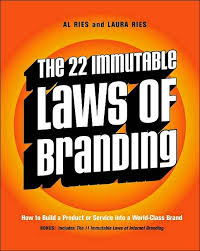 The 22 Immutable Laws of Branding: How to Build a Product or Service into a World-Class Brand
The 22 Immutable Laws of Branding: How to Build a Product or Service into a World-Class Brand
Written by: Al Ries and Laura Ries
Summarized by: Amie Hansen
Part 5
Chapter 9 – The Law of the Name
In the long run a brand is nothing more than a name.
Don’t confuse what makes a brand successful in the short term with what makes a brand successful in the long term.
In the short term, a brand needs a unique idea or concept to survive. It needs to be first in a new category. It needs to own a word in the mind.
In the long term, the unique idea or concept disappears. All that is left is the difference between your brand name and the brand names of your competitors.
Example: Xerox was the first plain-paper copier. This unique idea built the powerful Xerox brand in the mind. The difference between brands is not in the products, but in the product names. Or rather the perception of the names.
The most valuable asset of the Xerox Corporation is the Xerox name itself.
Rampant line extensions are destroying brands. (When you expand a brand, you reduce its power. When you contract a brand, you increase its power.)
Brands are the essence of the company itself. A company’s very existence depends on building brands in the mind.
Chapter 10 – The Law of Extensions
The easiest way to destroy a brand is to put its name on everything.
More than 90 percent of all new products introduced in the U.S. grocery and drug trade are line extensions. Many of those line extensions (at least in supermarkets) sit on the shelf and father dust.
This plethora of line extensions is the reason for the increased demands from retailers for trade promotions, slotting fees and return privileges. With so many products to choose from, retailers can force manufacturers to pay for the privilege of getting their products on the shelf. If one company won’t pay, the retailer can always find another company that will.
Example: There are 3 major beer brands – Budweiser, Miller High Life and Coors Banquet. Today these 3 brands have become 14. Have these 14 brands increased their market share over that obtained by the original 3 brands? Not really. Has the availability of these 14 varieties increased beer consumption? No.
When your customers are not exactly rushing our to buy your product, why would you need more brands to satisfy those customers?
Logic would suggest you would need fewer brands. But that’s customer logic. Manufacturer logic is different. If volume is going nowhere, the manufacturer concludes it needs more brands to maintain or increase sales. When a category is increasing in sales, there are opportunities for new brands, but manufacturer logic suggests they’re not needed. “We are doing great, we don’t need any more brands.”
As a result, the marketplace is filled with line extensions in areas where they are not needed and is starved for new brands in areas where they are needed.
One reason 90 percent of all new brands are line extensions is that management measures results with the wrong end of the ruler. It measures only the success of the extension. It never measures the erosion of the core brand.
Big powerful brands should have market shares approaching 50 percent, like Coca-Cola, Heinz, Pop-Tarts, Jell-O and Gerber’s. But it’s hard to find more than a few such brands. Most big brands have been line extended to death.
It’s the difference between building brands and milking brands. Most managers want to milk. “How far can we extend the brand?”
Many manufacturers are their own worst enemies. What are line extensions like light, clear, healthy and fat-free actually telling you? That the regular products are not good for you.
Let sleeping brands lie. Before you launch your next line extension, ask yourself what customers of your current brand will think when they see the line extension.
If the market is moving our from under you, stay where you are and launch a second brand. If it’s not, stay where you are an continue building your brand.



